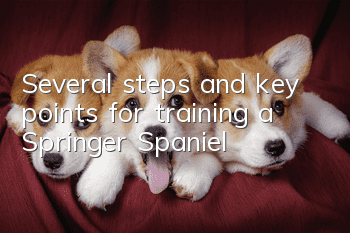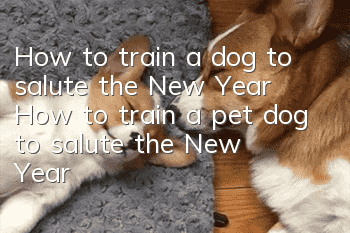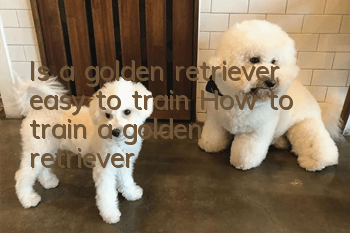Several steps and key points for training a Springer Spaniel

Methods of training dogs The basic methods of dog training include reward, punishment, induction, and coercion.
(1) Reward - Reward is the favorite training method for dogs. Through incentives, the dog's correct movements can be strengthened, the developed abilities can be consolidated, and the dog's neural activity state can be adjusted. ——Generally speaking, it is best to use food encouragement as little as possible, because often giving food rewards to dogs can easily lead to gluttony and food stealing. You can use verbal praise or touch the back of the ears, the nape of the neck, the top of the head or the bottom of the neck. The effect of this kind of spiritual reward is actually no worse than the effect of material reward.
(2) Punishment - Punishment is an effective means to stop a dog's bad behavior. When using this method, the trainer must have a serious attitude and a high-pitched and sharp tone. ——Severe punishments include pointing and scolding the dog, throwing stones and books at the dog, and beating with whips and sticks. Of course, these are not beatings with real swords and guns. The main purpose is to give the dog a threatening posture. , by stimulating its nerves, it will remember this lesson and never do it again. ——If the dog sneaks into the kitchen while the owner is not paying attention and eats all the food there, this behavior of the dog must be resolutely punished and never tolerated. The dog can be redirected to the food area in the kitchen and face the food. It yelled loudly, glared angrily, and raised the stick as if it wanted to hit it, so that it would become afraid of this place and its food stealing behavior, and would not repeat the same mistakes again. ——If your dog has a habit of eating feces, you must take severe punishment to make it stop the bad habit. The direct punishment method is to put feces and other dirt in front of the dog. When the dog eats, scold and beat it loudly. Then scold and remove the dirt, and then test it in the same way after a day or two until the dog no longer eats. ——If some dogs are pretending to be in front of you but still don't change their bad habits behind your back, you can use indirect punishment methods, pick up one or two stones, follow them secretly, and when you find that the dog is about to come into contact with the dirt, throw it out violently to make the dog frightened. The dog will think that it is the consequence of his own actions. If he repeats it a few times, the dog will overcome the viciousness of this quirk. Of course, there are other ways, that is, before the owner leaves, add some highly irritating and harmless items such as chili powder to the filth that the dog likes to eat. The dog will be unbearably spicy after eating it, and it will suffer on its own, and it will have a memory in the future. I never dare to eat again. ——In addition, some dogs like to tear slippers, toys, towels and other objects. Once discovered, they should be punished mercilessly. If it refuses to change after being taught repeatedly and becomes a habit, you must give it one or two painful lessons, otherwise it will not wake up easily.
(3) Induction - Induction refers to the use of delicious food, objects, trainer's actions, etc. to induce the dog to perform certain actions, thereby establishing a conditioned reflex.means. ——For example, if you want the dog to learn the correct command of "come", the trainer can tease it with a piece of meat in front of you, and the dog will definitely "come" obediently. At this time, you cannot reward the dog with meat. , then it will misunderstand that your "come" means "eat". If you repeat this many times, the dog will understand that the so-called "coming" is a process of walking to the owner from far to near. No meat is needed, and after a few more trainings, your dog will definitely understand your "come" command accurately.
(4) Force - Force refers to a method that uses mechanical stimulation and deterrent commands to force the dog to successfully complete a certain action. The so-called mechanical stimulation refers to behaviors such as pulling the traction rope, pressing, tapping and tapping. ——For example, if the trainer lifts the dog's collar with his right hand and presses the dog's waist with his left hand, the dog will inevitably sit down. Coercive methods are more direct than induction methods and are less likely to cause misunderstandings, allowing the dog to understand the meaning of the command while being forced to obey. This method is a bit simple and crude, and does not take into account the dog's voluntariness. But sometimes, the general saying of reprimanding has made the dog feel accustomed and commonplace, and it does not care about the so-called sincere inducement. At this time, the completion of some actions and the change of the dog's behavioral habits must be carried out by coercive means. For example, when some dogs bully small animals at home, and when it is useless to scold them loudly, you can give them strong stimulation to force them to make corrections. You can put food sprinkled with chili powder into the dog's mouth. , and help him put on a mask, so that he can change his past and repent under forced stimulation. This is relatively extreme coercion and punishment, but it is often one of the effective measures. ——Generally speaking, the intensity of coercion should not be excessive, and strong stimulation should only be given when necessary. The intensity should not be too high in the early stages of training, and should be used with caution on timid dogs.
- What should you pay attention to when breeding dogs?
- Dog parvovirus treatments and methods
- How to tell if your dog is pregnant?
- How to treat diarrhea in Beagle dogs?
- What are the personality traits of the Bernese Mountain Dog?
- How to tell if your dog is going to have a difficult birth? What do you need to prepare before delivering your dog?
- Which pet is more clingy? Do you know the top ten clingy pets?
- Pet owners need to know these vaccine basics
- How many times a day should I feed my dog?
- How to tell if Tibetan Mastiff is purebred



